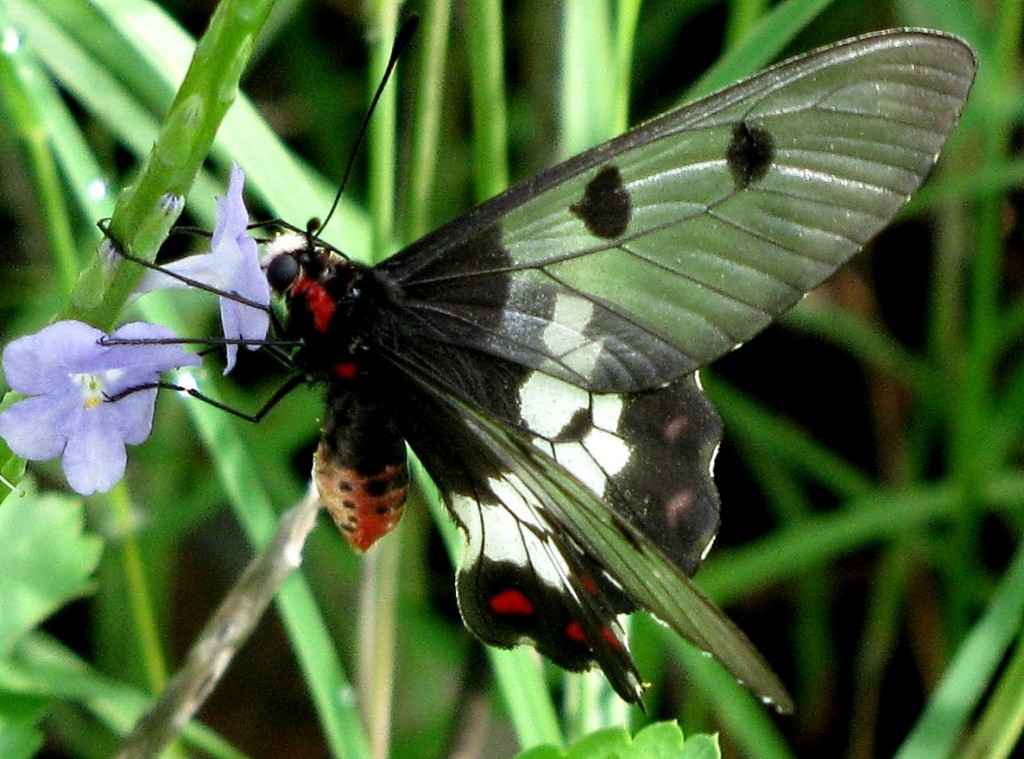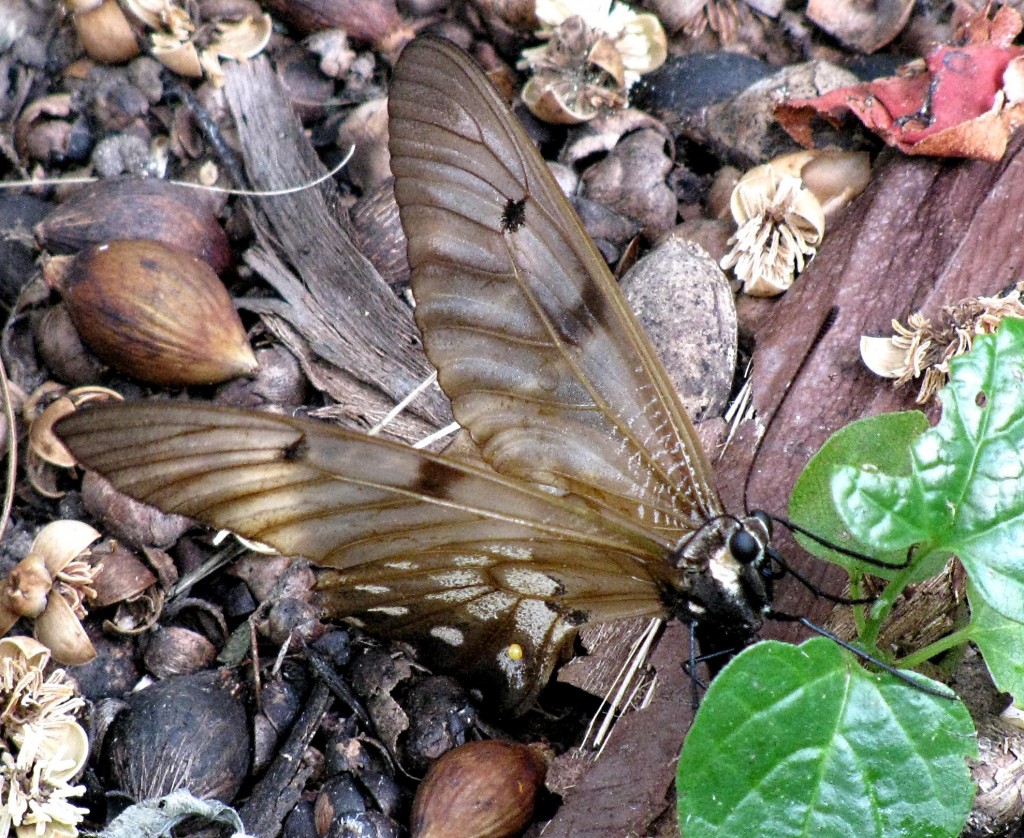When visiting the Melbourne Museum last month, I was mesmerized by the gorgeous butterfly displays. I stared longingly at brilliant green and black male birdwings and thought If only… This morning, I leapt from my chair and raced into the yard, having spotted what could only be a birdwing. Green and glorious, it glided high among the trees before sailing into the neighbour’s yard too quickly for me to photograph it.
On opening my butterfly guide1, from which all of the following technical information is derived, I learned that my birdwing was the Cairns birdwing, a locally common species, but one found only in the wet tropics of North Queensland and the Mackay region. (Technically, Townsville isn’t in the wet tropics, but it’s close to the dividing line). Two other species of birdwings also occur in eastern Australia – the New Guinea birdwing of northern Cape York and the Torres Strait Islands, and the Richmond birdwing found near the border of Queensland and New South Wales. Males of both the Cairns and New Guinea birdwings have wingspans of 12.5 centimetres or 5 inches, while the Richmond birdwing males stretch to 10 centimetres. Females of all birdwing species are larger than males, with the Cairns and New Guinea birdwing females stretching wings to 15 centimetres across.
The Australian birdwings belong to the butterfly family Papilionidae, as do the spectacularly beautiful black and blue Ulysses swallowtails and other large butterflies like the orchard swallowtail and clear-winged swallowtail. My guide informed me that the males of this butterfly family tend to congregate on hilltops, where males of several species will claim patches of hilltop as territories and defend those areas against other males.2
From my encounters with the male varied eggfly at Borrow Pits last weekend, I’ve become very aware of the fact that many butterflies possess strikingly different colours and patterns on the top and bottom planes of their wings. This is particularly true of the birdwing/swallowtail family, as is the occurrence of markedly different appearances of male and female butterflies of the same species. For example, a male Cairns birdwing viewed from above has wing patterns of green and black, and a black and yellow body, whereas a female Cairns birdwing viewed in the same way has wing patterns of brown, white, and yellow, and a dark brown body.3 Similarly, the male clear-winged swallowtail exhibits much brighter colours than the female clear-wing, as illustrated in the photographs below. In this particular feature, the identification of butterflies bears a strong affinity to that of birds.

Male Clear-winged Swallowtail (© Vilis Nams)

Female Clear-winged Swallowtail (© Magi Nams)
In the heat of early afternoon, I cycled to James Cook University to listen to a Ph.D. Pre-Completion Seminar presented by one of Chris Johnson’s graduate students, Brooke Bateman. Brooke, whom I had met previously at a JCU seminar, hypothesized that tropical animal species are sensitive to extreme weather events, not just long-term climate averages, and that such extreme events, as well as interactions with other animal species, must be considered when attempting to predict future population numbers and distributions for any given species. This is a particularly relevant topic in relation to predictions being made regarding the effects of climate change on animal populations.
Brooke’s study focussed on the northern bettong, an endangered species of small macropod found only in four areas of rainforest and eucalypt woodland in Queensland’s far north. From her talk, I learned that the northern bettong feeds on truffles, which it digs out of the soil, and in doing so, aids the dispersal of truffle spores. Since truffles provide food for many rainforest animal species, the northern bettong is considered to be a vital component of the plant and animal community; thus, scientists refer to it as a keystone species. After carrying out mathematical models incorporating many environmental factors plus a potential competitor, the rufous bettong, Brooke concluded that the projected increase in temperature and decrease in rainfall associated with climate change would cause already restricted populations of northern bettongs to become even more restricted. If the change in temperature were to be as great as 6ºC, the northern bettong would likely become extinct.
I cycled home after the seminar – spotting another male Cairns birdwing in the Ross River Parkway – and, with my interest excited by Brooke’s presentation, read up on bettongs in The Mammals of Australia. From this tome edited by Ronald Strahan, I learned that Australia has five living species of bettongs,4 all of which are smaller and have shorter hind feet than other macropods, even pademelons.5 The bettongs have semi-prehensile tails that they use to curl around and carry nesting materials, and they possess forefeet with strong claws5 that are used to dig up truffles, roots, and tubers.4 Only the northern and rufous bettongs occur in North Queensland.6 Photographs showed the bettongs as possessing grizzled fur and hunching on large hindquarters.4
During the evening, while contemplating future ‘going bush’ excursions, I came across the suddenly interesting bit of information that the Wallaman Falls campsite in Girringun National Park near Ingham (north of Townsville) is a good site to spot not only platypuses, but also bettongs.7 I think it’s soon time to pack the tent and sleeping bags again.
References:
1. Michael F. Braby. 2004. The Complete Field Guide to Butterflies of Australia. CSIRO Publishing, Collingwood, Victoria. pp. 124-125; 2. Ibid, pp. 17, 115-125; 3. Ibid, p.125; see also orchard and Ambrax swallowtails, pp. 118,123.
4. A.J. Dennis and P.M. Johnson. Rufous Bettong. pp. 285-287; R. Rose and K.A. Johnson. Tasmanian Bettong. pp.287-288; A.A. Burbidge. Burrowing Bettong. pp.289-291; P. Christensen. Brush-tailed Bettong. p. 292-293; J.W. Winter and P.M. Johnson. Northern Bettong. pp. 294-295. In: Ronald Strahan, editor. The Mammals of Australia. 1995. Reed New Holland, Sydney, pp. 285-295.
5. Ronald Strahan. Subfamily Potoroinae. The Mammals of Australia. 1995. Reed New Holland, Sydney. p. 285.
6. A.J. Dennis and P.M. Johnson. Rufous Bettong. p. 285; J.W. Winter and P.M. Johnson. Northern Bettong. p. 294. In: Ronald Strahan, editor. The Mammals of Australia. 1995. Reed New Holland, Sydney.
7. Emma Greg. The Rough Guide to East Coast Australia. 2008. Rough Guides, New York. p. 555.


